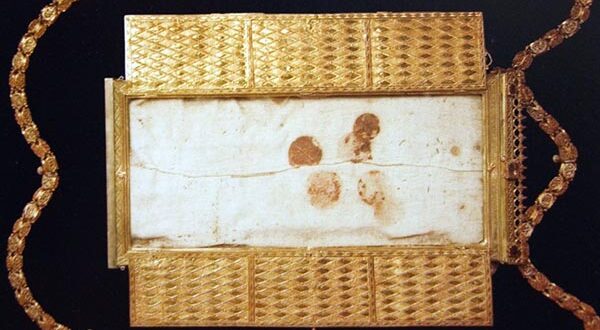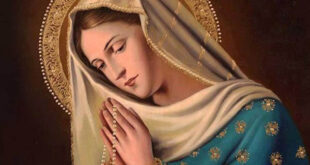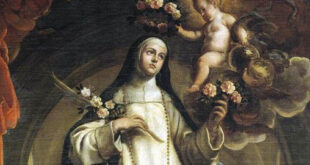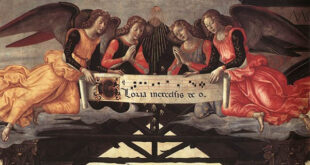The history of the Catholic Church is filled with miracles that have strengthened the faith of believers and served as visible signs of Christ’s real presence in the Eucharist. One of these prodigies, less known but of profound theological and historical significance, is the miracle of the Corporals of Daroca. Occurring in the 13th century, this event remains a living testimony to the centrality of the Eucharist in Christian life.
The Miracle of the Corporals: A Sign from Heaven
The event took place in 1239, in the context of the Reconquista on the Iberian Peninsula. The city of Daroca (now in the province of Zaragoza, Spain) was a Christian stronghold in a time of battles between Muslims and Christians for control of the region.
The Christian troops, composed of knights from various military orders, were preparing for battle against the Muslims in the town of Luchente (Valencia). Before the fight, a priest celebrated the Holy Mass and, as a precaution, placed the consecrated hosts in the corporals (the white linen cloths on which the Eucharist is placed during the liturgical celebration) because he did not want to leave the Blessed Sacrament in an unsafe place.
However, before they could consume the hosts, they were attacked. The priest hid the corporals with the consecrated hosts inside a chest and joined the battle. When the soldiers returned after the fight and opened the chest, they were astonished: the hosts had bled and left their imprint on the corporals, as if they had been soaked in the Precious Blood of Christ.
This miracle was interpreted as a divine sign of Christ’s real presence in the Eucharist and His support in the difficult mission of the Reconquista.
From Luchente to Daroca: The Pilgrimage of the Miracle
The knights who witnessed the miracle could not agree on where the relic should remain. To resolve the dispute, they decided to place the corporals on a riderless mule and let God determine its destination.
The mule, carrying the precious burden, embarked on a journey of more than 200 kilometers without stopping until it reached Daroca, where it finally collapsed and died, signifying that this was the place where the corporals should be venerated. From then on, the city became a center of pilgrimage and Eucharistic devotion.
Theological Significance of the Miracle
The miracle of the Corporals of Daroca reinforces a central truth of the Catholic faith: the Real Presence of Christ in the Eucharist. This doctrine, dogmatically defined at the Council of Trent (1545-1563) and consistently reaffirmed by the Church, teaches that the bread and wine consecrated at Mass truly become the Body and Blood of Christ, even though they retain their external appearance of bread and wine.
This miracle reminds us that the Eucharist is not merely a symbol but a supernatural reality in which Christ is truly present, offering Himself for us and renewing His redemptive sacrifice.
Furthermore, the event in Daroca reinforces the importance of Eucharistic adoration. If Christ is truly present in the consecrated Host, then the Church is right to venerate Him with deep devotion, promoting adoration of the Blessed Sacrament as a source of grace and spiritual strength.
Relevance of the Miracle Today
In a world where faith in the Eucharist has weakened in many sectors, the miracle of the Corporals of Daroca remains a call to rediscover the centrality of the Blessed Sacrament in Christian life. Today, many Catholics have lost awareness of the real presence of Christ in the Mass, and in some cases, the Eucharist is seen more as a social ritual than as the living encounter with the Lord.
This miracle is a reminder that Christ is still among us in a real and tangible way at every Mass. As Saint John Paul II taught:
“The Church lives from the Eucharist. This sacrifice is truly at the heart of the world, the secret of its renewal and its future” (Ecclesia de Eucharistia, 1).
The miracle also invites us to reflect on the reverence with which we approach the Eucharist. If these miraculous hosts speak to us of Christ’s Blood shed for us, how can we receive Communion without proper preparation and due respect? The Church exhorts us to confess regularly and to receive the Body of Christ with a pure and well-disposed heart.
Conclusion: An Invitation to Rediscover the Eucharist
The story of the Corporals of Daroca is not just a tale from the past but a living sign that still speaks today. It is a call to deepen our understanding of the Eucharistic mystery, to strengthen our faith in the Real Presence, and to adore Christ in the Blessed Sacrament with fervor.
May this miracle inspire us to live the Mass with greater devotion, to adore the Eucharist with love, and to rediscover in every consecrated Host the same Christ who loved us to the Cross and continues to give Himself for us on the altar.
How Can We Live This Miracle in Our Lives Today?
- Visiting the Blessed Sacrament regularly in Eucharistic adoration.
- Receiving the Eucharist with a pure heart and with awareness that it is truly the Body of Christ.
- Teaching others, especially the younger generations, about the importance of the Mass and Communion.
- Renewing our faith in the Eucharist, knowing that it is the greatest gift Christ left us.
May the Virgin Mary, the Eucharistic Woman par excellence, help us to understand and love more deeply this mystery of infinite love.
“Lord, give us a Eucharistic heart, so that, like those knights of Daroca, we may recognize You in the Bread of Life and bring You to every corner of the world.”






